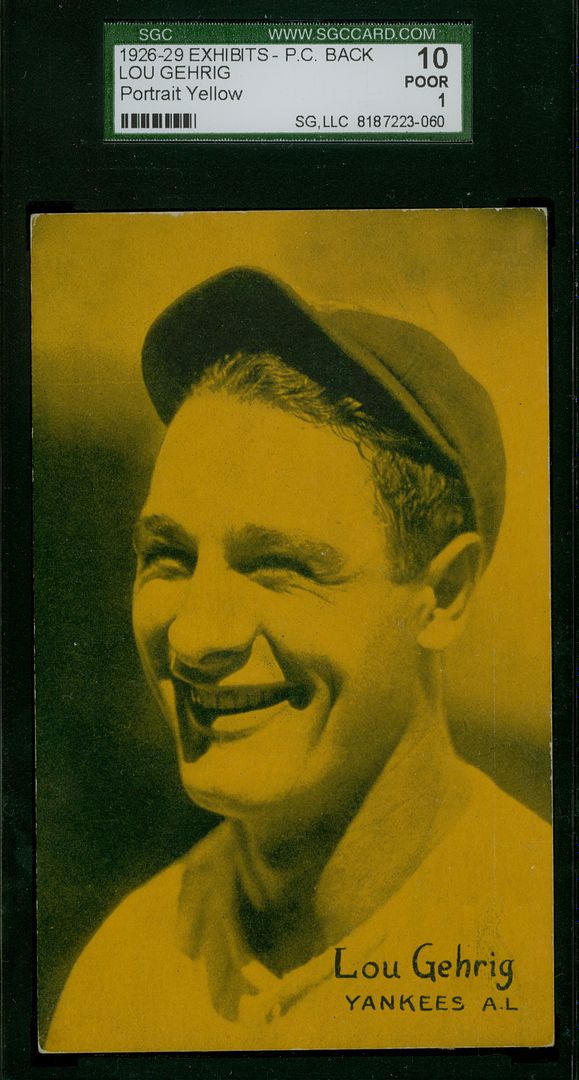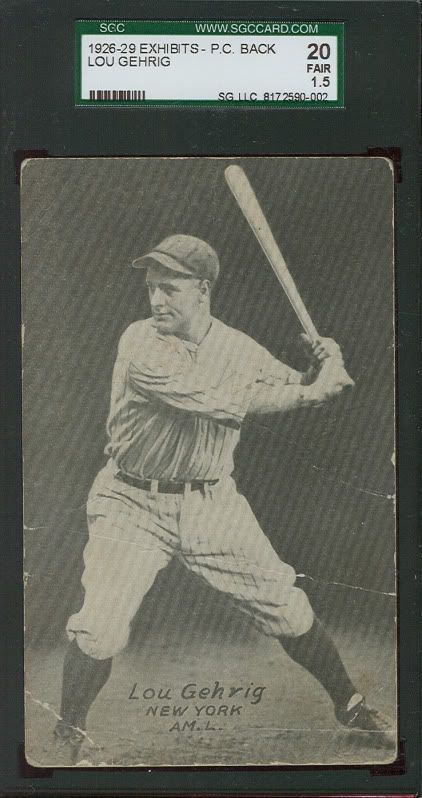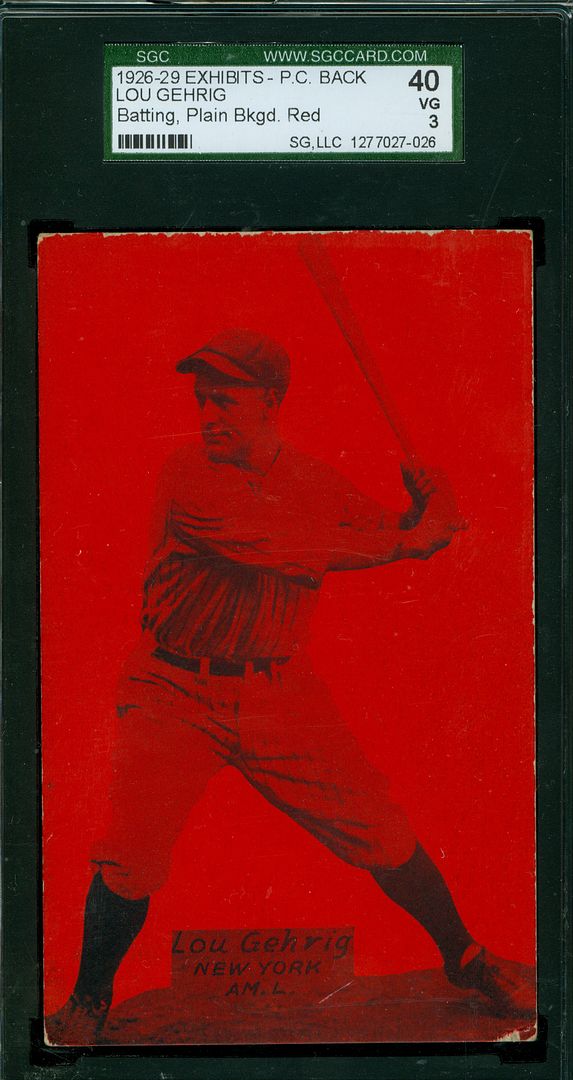|
|
|
|
#1
|
||||
|
||||
|
Seems to be wildly varying info and opinions (and grading) online on those Gehrig "exhibits" with postcard backs from around 1928 -- some are considered "plain" background and others "picture" background but very inconsistent on which is which. It's the same batting pose in any case. Can you weigh in?
|
|
#2
|
||||
|
||||
|
On the 1926-29 (1925-31 actual) Exhibit Postcard Back Exhibits, Lou Gehrig has three different cards, a portrait, a batting photo and a batting plain background (silhouette). The Plain background are the toughest cards in this set by a lot and can bring 2-5 times the price of the photo version. I know 4 collectors down to only needing the plain/silhouette cards to complete their sets, myself included. Also PSA cant seem to get these right as so many are mislabeled, SGC does a better job but I have still seen a few mislabeled, also VCP prices on these can be a mess too as many have been sold graded but mislabeled. Here are the three examples-
  
|
|
#3
|
|||
|
|||
|
Since you note 1925-31 and not 1926-29 as SGC and PSA designate. Does this mean that all the Gehrig ones would be considered as his rookie card/s and not just the one currently as the 1925 per grading companies??
|
|
#4
|
|||
|
|||
|
I do not believe that any of the Gehrigs from the postcard-back set were produced in 1925, thus eliminating them from possible Rookie Card status.
Last edited by bcbgcbrcb; 09-17-2012 at 06:17 AM. |
|
#5
|
||||
|
||||
|
I don't think we can conclusively rule that out, Phil. The “father” of Exhibit card cataloguing, Elwood “Woody” Scharf, reported in 1979, without elaborating on his sources, that a black and white first printing of the set was issued in 1925. The initial runs of the issue were made with blank backs or backs that had a postcard design with the words “THIS SIDE FOR CORRESPONDENCE” printed on them. Later runs substituted the phrase “NOT TO BE USED IN EXHIBIT MACHINES” for the “correspondence” legend, and still-later print runs added “MADE IN USA” to the card backs. A black and white, blank-backed or "this side for correspondence" backed example of the Gehrig batting card could be a 1925 product. I have yet to see a blank-backed Gehrig card or a "correspondence" card. Best I think we can say is that unless/until one surfaces, the Gehrig cards fit into 1926 and later. What we need [but obviously cannot find] is a sheet or an advertising piece that could put the issue to bed.
I think a 1925 first printing is quite likely, and I believe that the print run on the last of these cards ran into 1931, with numerous alterations of the print run in mid-stream. Consequently, the postcard-backed set is rife with short prints of varying degrees of rarity as players apparently were dropped and added into the print run. The inclusion of Everett Scott as a Yankee presents a compelling case for an early 1925 first issue date. The Yankees sold Scott to the Senators on June 17, 1925. He was waived at the end of the season, selected off waivers by the White Sox in March 1926, waived again and selected by the Reds on July 6, 1926. He played his final game in the majors on July 27, 1926. Scott’s multiple team changes after June 1925 make it very unlikely that his card was first issued in 1926. I suspect that his card, which is very tough to find, was issued in 1925 and dropped with the first revision of the set after the 1925 season. As for a the plain background cards, or silhouette cards as I call them, Faber, Gehrig, Hartnett, Sisler, Speaker, Todt, Waner and Jimmy Wilson exist with images that either have or do not have backgrounds. In practical terms it appears that ESCO cut out silhouettes of the players and the legends from original hand-inked photos and created new printing plates for the silhouette cards. I can now say definitively that they did not go back and mutilate the old photos because Waner and Speaker original art surfaced within the last year--if they'd been cut apart the art would reflect that.  In all cases the silhouette cards are much harder to find than their full background brothers; I classify them all as short prints. I think ESCO tried to stretch their existing materials by creating the silhouette cards and adding them to the print run some time in 1928, based on Tris Speaker’s inclusion in the silhouette group. Speaker’s card shows him in a Washington uniform listed as an Athletic. His card has to be a 1928 issue; Speaker played in Washington in 1927 and went to the A’s in 1928. I suspect it was a one-year card as well because Speaker played only 64 games in 1928 before retiring.
__________________
Read my blog; it will make all your dreams come true. https://adamstevenwarshaw.substack.com/ Or not... Last edited by Exhibitman; 09-17-2012 at 11:32 AM. |
|
#6
|
||||
|
||||
|
Here are the front and back scans of the Everett Scott card (which I sold long ago)...
|
 |
|
|
 Similar Threads
Similar Threads
|
||||
| Thread | Thread Starter | Forum | Replies | Last Post |
| SOLD: 1928 Yankees Team signed ball w/ Gehrig | gnaz01 | Baseball Memorabilia B/S/T | 4 | 08-23-2012 08:47 AM |
| Foxx vs Gehrig | Touch'EmAll | Net54baseball Vintage (WWII & Older) Baseball Cards & New Member Introductions | 20 | 02-13-2011 08:24 PM |
| Quick Gehrig question | yanks12025 | Net54baseball Sports (Primarily) Vintage Memorabilia Forum incl. Game Used | 5 | 06-05-2010 08:24 PM |
| Need a quick answer on this one - ref. stains on a card | Archive | Net54baseball Vintage (WWII & Older) Baseball Cards & New Member Introductions | 2 | 02-20-2009 08:45 PM |
| ca. 1927 Tabacalera La Morena Ruth & Gehrig card | Archive | Net54baseball Vintage (WWII & Older) Baseball Cards & New Member Introductions | 4 | 05-27-2008 09:08 AM |